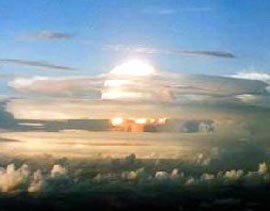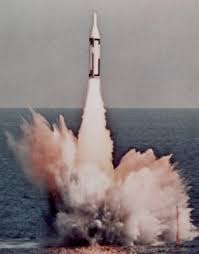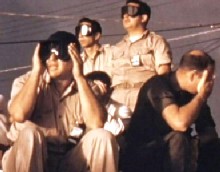 |
|
America's Nuclear Weapon Program
The United States was the first nation to develop nuclear weapons. This development of nuclear weapons began during World War 2, initially to counter German nuclear research, and later to counter percieved Soviet aggression. This initial program code named the Manhattan Project (officially known as the Manhattan Engineer District), was conducted from 1942 to 1946 and cost the nation over $2 billion dollars ($23.4 billion 2010 USD). Over 90% of the cost was for building plants and producing the fissionable materials, and less than 10% for development and production of the weapons.
Extensively assisted by Great Britain and Canada, the project enlisted the world's top scientists, many of
which fled Europe after the outbreak of World War 2, and employed over 130,000 people. After the war, the Manhattan Engineer District was dissolved and control of nuclear energy fell to the the civilian Atomic
Energy Commission.
Physicist J. R. Oppenheimer lead the scientific research effort during the Manhattan Project, while overall
leadership was given to General Leslie R. Groves. A secret laboratory at Los Alamos, in New Mexico, was
chosen as the main location for the project. A plutonium-production facility was constructed at what is now
Hanford Site, and uranium-enrichment facilities at what is now Oak Ridge National Laboratory. These two
plants produced the nuclear fissile material which went into the first nuclear weapons.
The United States successfully tested a nuclear bomb on July 16, 1945 in the New Mexico desert. The test,
code named Trinity, was of a plutonium implosion device, which was later converted into an air deliverable
nuclear bomb called 'Fatman'. A second atomic bomb developed during the Manhattan Project, called “Little Boy”, was a uranium gun-type weapon. These weapons were subsequently used against Japan, killing an estimated 200,000 people and effectively ending WWII. This was the only use of nuclear weapons in combat to this day.
"We knew the world would not be the same. A few people laughed, a few people cried, most people were silent. I remembered the line from the Hindu scripture, the Bhagavad-Gita. Vishnu is trying to persuade the Prince that he should do his duty and to impress him takes on his multi-armed form and says, "Now, I am become Death, the destroyer of worlds." I suppose we all thought that one way or another."
- J. Robert Oppenheimer
|
Following the war, an extensive series of nuclear tests was conducted by the United States, lasting from 1946 till 1992. Over one thousand nuclear devices were detonated by the United States during the Cold
War. The first of these test series was Operation Crossroads. Conducted at Bikini Atoll in 1946, Crossroads tested two plutonium implosion bombs identical to the one dropped on Nagasaki. The first test, Able, was detonated over a ghost fleet compromised of over 70 ships. The second test, Baker, was detonated underwater in the center of the fleet. These tests were the first weapons effects tests ever conducted and primarily explored the response of naval vessels to the effects of an atomic detonation.

Ivy Mike - November 1, 1952
|
On November 1, 1952, the United States detonated a hydrogen bomb during Operation Ivy. Codenamed Mike, the explosion had a yield of 10.4 megatons and completely obliterated the island where it exploded. This bomb was several times more powerful then all of the explosives detonated during both World Wars combined. The development of thermonuclear weapons was made possible mainly due to the breakthrough research done by physicists Edward Teller and Stanislaw Ulam.
Between 1945 to 1962 the United States tested over 200 nuclear devices in the atmosphere, underwater, and in outer space. These tests marked the atmospheric nuclear testing era, in which many of the major advances in nuclear weapons technology occurred. 20 nuclear testing series were conducted by the United States during this time at various locations around the world, mainly in the deserts of the southwest United States and remote Pacific atolls. In 1963, the United States signed the Limited Test Ban Treaty, prohibiting all atmospheric detonations of nuclear weapons.
Nuclear tests were organized into separate operations. Depending on weapons objectives, these operations had specific weapons development goals and effects studies. These nuclear tests proof tested warheads for entry into the U.S. Stockpile, tested new concepts being developed in the nation's research laboratories, and studied the effects of nuclear detonations. Despite the secrecy surrounding these tests, most operations were announced to the general public and several featured open tests, in which civilians and members of the press were allowed to observe nuclear detonations.
U.S. nuclear testing ceased on September 23, 1992 with the last nuclear test to date fired at the Nevada
Test Site. The United States signed the Comprehensive Test Ban Treaty on September 24, 1996. Though not yet in force, the treaty bans all nuclear testing, for civilian and military purposes alike.
The first thermonuclear weapon entered the stockpile in 1954. The Mk-16 was a large, cryogenic two-stage hydrogen bomb and had a 6 to 8 megaton yield. Only five Mk-16s were built. The Mk-14 was the first solid fueled hydrogen bomb and entered the stockpile shortly after the Mk-16. The Mk-15 was the first lightweight thermonuclear bomb and it entered the stockpile in 1955. The first missile warhead, the W-5, was produced in 1954. Deployed on the Regulus and Matador missiles, it was essentially a modified Mk-5 bomb warhead.
 In 1959, the first U.S. ICBM went operational, the Atlas. The Atlas program was started in 1955 mainly
due to CIA data on the accelerated Soviet ICBM program. The launch of Sputnik in 1957 was not only a
dramatic demonstration of Soviet space technology, but also a demonstration that the USSR now had a
means to deliver nuclear weapons anywhere in the world. The Sputnik crisis which followed the launch of
the satellite was a turning point in the Cold War and initiated a new generation of strategic defense.
In 1959, the first U.S. ICBM went operational, the Atlas. The Atlas program was started in 1955 mainly
due to CIA data on the accelerated Soviet ICBM program. The launch of Sputnik in 1957 was not only a
dramatic demonstration of Soviet space technology, but also a demonstration that the USSR now had a
means to deliver nuclear weapons anywhere in the world. The Sputnik crisis which followed the launch of
the satellite was a turning point in the Cold War and initiated a new generation of strategic defense.
The first U.S. nuclear powered submarine, the USS Nautilus (SSN-571), became operational in January
1955. The first SSBN equipped with SLBMs (submarine-launched ballistic missile) was the USS George Washington (SSBN-598). She entered service in 1960 and was equipped with the Polaris A1 SLBM. The first U.S. MIRV capable missile, the Minuteman III, entered service in 1970.
In 1968 the United States signed the Nuclear Non-Proliferation Treaty (NPT). The purpose of the NPT was
to limit the spread of nuclear weapons technology, initiate disarmament and liquidation of nuclear
stockpiles, and limit to use of nuclear energy to peaceful purposes. Five nuclear weapons states are
officially recognized by the NPT; United States, Russia, Great Britain, France, and China. The NPT,
which was proposed by Ireland, was opened for signature in 1968. By 1992 all five nuclear weapons states
had signed and the treaty was renewed in 1995.
The United States built over 70,000 nuclear weapons since 1945. The peak number of weapons stockpiled
was in 1967 with approximately 32,500 warheads in existence. Today, the United States has approximately 10,000 stockpiled warheads, of which about 5,735 are considered active or operational. The United States currently has approximately 500 Minuteman III ICBMs and 250 Trident II SLBMs. These missile forces are equipped with approximately 3,420 nuclear warheads. Approximately 1,750 nuclear warheads are deployed on B-2 and B-52 bombers. These active nuclear weapons have a total yield equivalent to 1,560 megatons of TNT.
Nuclear Testing
The United States conducted the largest number of nuclear tests of any nation. Between 1945 to 1992,
1,125 nuclear devices were detonated by the United States, the majority of these were weapons
development and effects tests. Some of these tests were for peaceful uses of atomic energy, including
land excavation and gas stimulation projects.
The United States conducted 210 atmospheric nuclear tests between 1945 to 1962. The majority of these
tests took place at the Pacific Proving Grounds or at the Nevada Test Site. The atmospheric nuclear
testing era marked the height of nuclear weapons research and development, and dramatically symbolized
the danger facing the world during the Cold War.
Test Objectives
Weapons Development (WD) - Primary objectives included testing and proving principles or parameters
relating to the design of the nuclear device, testing of experimental device components, or proof
testing nuclear weapons prior to their entrance to the nation's stockpile of nuclear weapons. Details of
WD tests remain largely classified to this day.
Weapons Effects (WE) - These tests were concerned with the effects and phenomena caused by
nuclear explosions rather then the mechanisms which made the weapons work. Effects were studied in the
interest of both military and civilian applications. Often various materials were exposed to the
explosion to study their responses to blast, heat, light, and radiation.
Peaceful Nuclear Explosions (PNE) - PNEs were detonations of nuclear devices intended for civil
use of nuclear energy. Often these included large scale land excavation and gas stimulation projects.
The U.S. PNE program was called Plowshare and consisted of 27 nuclear detonations. The program was
initiated in 1961 and ended in 1973. None of the Plowshare tests were ever used for commercial purposes.
Often, a nuclear test was a combined WD and WE experiment, with a scientific laboratory being
responsible for the WD aspect of the test, and either a military or civilian organization responsible
for the WE aspect of the test.
Test Methods
Towers - Nuclear devices were placed on the top of towers, ranging in height from several feet to
hundreds of feet and were constructed out of wood or metal. Towers provided a means of reducing
radioactive fallout resulting from nuclear tests and also were used to prevent cratering of land
surface. This prevention was especially important at the Pacific Proving Grounds, were land area was
limited to small, coral islands.
 Air Drops - Air drops provided the opportunity to test nuclear weapons in a weaponized form.
Devices were placed inside bomb casings of various sizes and dropped by bomber aircraft over the testing
range. Air drops also were much more efficient at reducing radioactive fallout resulting from nuclear
explosions then towers. However, experimental devices, too large or complex to be dropped from an
aircraft, were not suitable for this method of testing. Air drops also needed to be highly accurate so
that data from the explosions could be efficiently collected by sensitive diagnostic instruments.
Air Drops - Air drops provided the opportunity to test nuclear weapons in a weaponized form.
Devices were placed inside bomb casings of various sizes and dropped by bomber aircraft over the testing
range. Air drops also were much more efficient at reducing radioactive fallout resulting from nuclear
explosions then towers. However, experimental devices, too large or complex to be dropped from an
aircraft, were not suitable for this method of testing. Air drops also needed to be highly accurate so
that data from the explosions could be efficiently collected by sensitive diagnostic instruments.
Balloons - Balloons were used for the testing of nuclear devices as an alternative to a tower or
an air drop. Balloons could be hoisted to a predetermined height were minimal fallout would occur as a
result of the explosion.
Barges - Barges were used for the detonation of nuclear devices at the Pacific Proving Grounds.
Barges were towed either out into the open sea or out into the lagoon of an atoll where they would be
detonated. This method saved valuable real estate from cratering but created much more fallout then
towers, air drops, or balloons.
Rockets - Rockets were used to test devices in weaponized form or at high altitudes for WE
studies. This method of testing was limited to warheads small enough to be placed on a rocket. Rockets
also were the most dangerous method of conducting nuclear tests in respect to safety.
Underground - Nuclear devices were detonated underground either at the end of a tunnel
(horizontal) or shaft (vertical). With the signing of the Limited Test Ban Treaty in 1963, all U.S.
Nuclear testing went underground. This method of testing is the cleanest as, ideally, all radioactive
products are trapped underground and can not escape into the atmosphere. Other types of underground
testing involved cratering studies, in which the nuclear explosion was deliberately not fully contained
underground. This type of testing provided the greatest security and safety advantages.
Underwater - This type of testing was used primarily for WE studies, but also for WD studies.
Nuclear devices would be detonated underwater at various depths to study their effects on naval
equipment, as well as to study natural phenomena caused by such explosions.
Nuclear Arsenal
The United States developed the largest nuclear arsenal in the world, and currently has the second
largest stockpile of nuclear weapons behind Russia. The U.S. Deployed nuclear weapons on Intercontinental Ballistic Missiles (ICBM), Intermediate Range Ballistic Missiles (IRBM), Submarine Launched Ballistic Missiles (SLBM), Air-to-Surface Missiles, Ground and Sea-launched cruise missiles, gravity bombs, artillery pieces, and anti-submarine weapons. These weapons systems were delivered by aircraft, submarines and surface vessels, mobile ground vehicles, and fixed land based launch facilities to list a few.
|
|
|
 |





 In 1959, the first U.S. ICBM went operational, the Atlas. The Atlas program was started in 1955 mainly
due to CIA data on the accelerated Soviet ICBM program. The launch of Sputnik in 1957 was not only a
dramatic demonstration of Soviet space technology, but also a demonstration that the USSR now had a
means to deliver nuclear weapons anywhere in the world. The Sputnik crisis which followed the launch of
the satellite was a turning point in the Cold War and initiated a new generation of strategic defense.
In 1959, the first U.S. ICBM went operational, the Atlas. The Atlas program was started in 1955 mainly
due to CIA data on the accelerated Soviet ICBM program. The launch of Sputnik in 1957 was not only a
dramatic demonstration of Soviet space technology, but also a demonstration that the USSR now had a
means to deliver nuclear weapons anywhere in the world. The Sputnik crisis which followed the launch of
the satellite was a turning point in the Cold War and initiated a new generation of strategic defense.

 Air Drops - Air drops provided the opportunity to test nuclear weapons in a weaponized form.
Devices were placed inside bomb casings of various sizes and dropped by bomber aircraft over the testing
range. Air drops also were much more efficient at reducing radioactive fallout resulting from nuclear
explosions then towers. However, experimental devices, too large or complex to be dropped from an
aircraft, were not suitable for this method of testing. Air drops also needed to be highly accurate so
that data from the explosions could be efficiently collected by sensitive diagnostic instruments.
Air Drops - Air drops provided the opportunity to test nuclear weapons in a weaponized form.
Devices were placed inside bomb casings of various sizes and dropped by bomber aircraft over the testing
range. Air drops also were much more efficient at reducing radioactive fallout resulting from nuclear
explosions then towers. However, experimental devices, too large or complex to be dropped from an
aircraft, were not suitable for this method of testing. Air drops also needed to be highly accurate so
that data from the explosions could be efficiently collected by sensitive diagnostic instruments.
